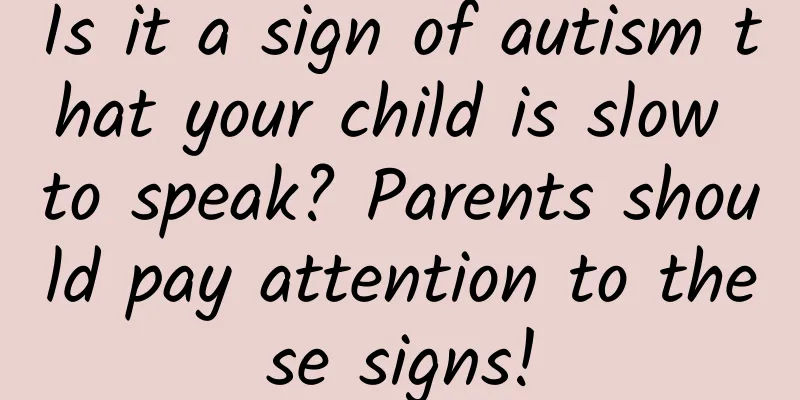Is it a sign of autism that your child is slow to speak? Parents should pay attention to these signs!

|
"When the child was two years old and didn't speak, the elders said it was a sign of late speech. But when he was still silent at three years old, we realized the seriousness of the problem." This is the common confusion of many families with children on the autism spectrum. This issue will unveil the mystery of autism spectrum disorder (ASD) and overturn the public's traditional perception of this special group. What is Autism Spectrum Disorder? Autism spectrum disorder (hereinafter referred to as ASD) is a neurodevelopmental disorder characterized by social interaction disorders, communication difficulties and repetitive stereotyped behaviors. According to statistics, in the United States alone, the prevalence of ASD reached 2.78% in 2020, equivalent to 1 in every 36 children being diagnosed. If we look at the world, the ASD patient group has exceeded 80 million, and focusing on China, based on a conservative prevalence of 1%, there are at least 3 million to 5 million "star children" among children aged 0-14. The core symptoms of ASD present multi-dimensional functional impairment characteristics, among which language development abnormalities are particularly significant - about 30% of children completely lose their ability to speak, and more patients show "mechanical language" characteristics, such as mechanically repeating advertising phrases but unable to have contextual conversations. There are also obvious social barriers, such as avoiding eye contact, difficulty understanding the emotional meaning behind facial expressions, and other difficulties in decoding social signals. Stereotyped behavior patterns run through daily life, including repetitive body movements such as clapping and turning in circles, as well as pathological resistance to environmental changes (such as an 8-year-old child who continued to scream due to a temporary adjustment in his route to school). How to intervene and rehabilitate autism As a mainstream intervention method, traditional ABA therapy (Applied Behavior Analysis) faces challenges in clinical practice due to its behavioral theory. This therapy shapes specific behaviors through external reinforcement mechanisms (such as food rewards or token systems). However, it is worth noting that this training model often causes "generalization difficulties". The behaviors such as obedience to instructions and social responses learned by children with spectrum disorders in the treatment room are difficult to use in natural scenarios such as home and school. The integrated intervention program implemented by Beibei Children's Rehabilitation Guidance Center adopts a multi-dimensional intervention strategy. First, the physiological condition of children is assessed through biomedical testing; then targeted cognitive language, sensory motor and other rehabilitation interventions are carried out; guidance for children's families is also strengthened, including strict control of the use of electronic devices to avoid excessive screen exposure that exacerbates social avoidance tendencies, and building a family support network to relieve intergenerational parenting pressure, with special attention to preventing the double squeeze effect of grandparents' pampering and parents' anxiety. Clinical case: A 7-year-old autistic child with obvious aggressive behavior. After communicating with the parents, we also found that the child had a serious picky eating problem. After Beibei Children's Rehabilitation Guidance Center implemented the integrated intervention program for 3 months, the incidence of abnormal behavior of the child was greatly reduced, and the frequency of actively initiating social interactions increased to several times the baseline level, which effectively verified the practical value of the interdisciplinary collaboration model in the intervention of neurodevelopmental disorders. Family Guide to Early Identification Parents need to pay special attention to signs of deviation from infants' developmental milestones: if the baby does not respond to calling his name when he is one year old and lacks basic communication skills to point to the objects he needs, it should be a cause for alarm; if the child has not developed symbolic play skills by 18 months old (for example, he cannot feed a doll with a toy spoon), there may be obstacles to social cognition; if the child has a spoken vocabulary of less than 50 words at the age of two and exhibits abnormal behaviors (such as continuously staring at a spinning fan, spinning toy wheels aimlessly, and repeatedly fiddling with a toy aimlessly), these are warning signs of autism spectrum disorder. In terms of parenting strategies, parents often fall into three major misunderstandings - some families take overprotective measures because their children have sensory sensitivity problems, completely isolating their children from social situations, which accelerates the degradation of their social functions. Research data shows that children who rely on electronic devices (using screens for more than two hours a day) have a three times higher risk of language delay than the normal group. What is more alarming is that some physical discomfort is often misdiagnosed as behavioral problems. We once treated a child with a spectrum disorder who repeatedly banged his head against the wall. After relevant examinations and evaluations, we found that the child banged his head against the wall to relieve the severe pain caused by otitis media. These warning cases highlight the importance of accurate identification and scientific response. From "different" to "growing together" When we unveil the pathological veil of "autism", we see not only medical problems, but also a profound understanding of human neurodiversity. These children are not defective products that need to be "corrected", but messengers who come to the world with special codes. Scientific intervention is not to eliminate differences, but to help them find a way to communicate with the world. With breakthroughs in genetic research and neuroplasticity, a complete ecosystem of early "screening-precision intervention-social support" is taking shape. Perhaps one day in the future, when a "star child" suddenly says "Mom, I love you", we will understand better: this is not a miracle, but a dawn illuminated by science and understanding. (Author: Feng Yu, Master of Pediatrics, Director of the Medical Department of Beibei Children's Rehabilitation Guidance Center) This article is based on the Thursday night school content of Zhejiang Science Popularization Federation |
<<: Correct sleeping posture to protect the cervical spine
>>: Is starving healthy? The truth about intermittent fasting
Recommend
Why is there pain when pressing the ovaries?
Gynecological diseases in women are very common c...
Can I eat black vinegar during menstruation?
Can you eat black vinegar during menstruation? Wh...
How to check the length of the cervix
Many female friends who are pregnant for the firs...
Weiboyi: 2020 KOL social media advertising analysis report
The PDF version will be shared on 199IT Knowledge...
Can I use moxibustion on my belly during pregnancy?
Moxibustion is a Chinese medicine treatment, simi...
When do yellow bananas and apples ripen? When is the ripening season for Huang Yuanshuai apples?
Yellow banana apples are actually ordinary apples...
Girls' breast development time
Girls' breast development occurs in certain s...
What causes women's swollen legs and feet
Edema is often a signal of some diseases. Heart d...
Friends with diabetes, do you know how to measure your blood sugar?
This is the 3626th article of Da Yi Xiao Hu Self-...
What are the best beaches in the Maldives? What delicious food is there in the Maldives?
There is a famous delicacy in the Maldives called...
What causes uterine contraction?
We all know that women will experience menopause ...
How to solve the problem of abnormal leucorrhea without odor
Abnormal leucorrhea but no odor should not be ign...
2023 "Pharmaceutical Popular Science Works" Essay Exhibition | Don't be affectionate to me, would you use lozenges?
Lozenges are tablets that are held in the mouth t...
What is the earliest sign of pregnancy?
Pregnancy is one of the most important periods in...









